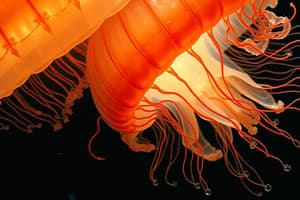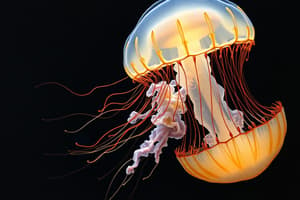Podcast
Questions and Answers
Comb jellies may have evolved from coelenterates.
Comb jellies may have evolved from coelenterates.
True (A)
Comb jellies are considered plankton.
Comb jellies are considered plankton.
True (A)
Fresh water comb jellies are exclusively tropical.
Fresh water comb jellies are exclusively tropical.
False (B)
Scientists use plankton nets to collect comb jellies.
Scientists use plankton nets to collect comb jellies.
There are over sixty species of ctenophores.
There are over sixty species of ctenophores.
Many comb jellies are bioluminescent.
Many comb jellies are bioluminescent.
Unlike many jellyfish, comb jellies are usually colorless.
Unlike many jellyfish, comb jellies are usually colorless.
Comb jellies often swarm in large aggregations.
Comb jellies often swarm in large aggregations.
Sharks eat comb jellies.
Sharks eat comb jellies.
Beroe's comb jelly was named after the Greek goddess of hair, Beroe.
Beroe's comb jelly was named after the Greek goddess of hair, Beroe.
What class are comb jellies a part of?
What class are comb jellies a part of?
What likes jellyfish?
What likes jellyfish?
What do comb jellies prey on?
What do comb jellies prey on?
Do comb jellies contain both female and male parts?
Do comb jellies contain both female and male parts?
How long can their tentacles grow?
How long can their tentacles grow?
Flashcards are hidden until you start studying
Study Notes
Comb Jellies Overview
- Comb jellies may have evolved from coelenterates, suggesting a potential ancestral link.
- Classified as plankton, they drift and are carried by ocean currents.
- Not exclusively tropical; fresh water comb jellies can exist in various climates.
Collection and Species
- Plankton nets are ineffective for collecting comb jellies; other methods are typically employed.
- There are over one hundred species of ctenophores, contrary to some misconceptions.
Characteristics and Behavior
- Many species of comb jellies exhibit bioluminescence, allowing them to emit light.
- Generally, comb jellies are colorless, differentiating them from many jellyfish that display vibrant colors.
- They often form large swarms or aggregations in aquatic environments.
Predation and Ecology
- Sharks are known to prey on comb jellies, showcasing their role in the marine food web.
- Comb jellies prey on plankton, larvae, and roe, serving as predators in the ecosystem.
Biological Traits
- Comb jellies are hermaphroditic, containing both male and female reproductive parts.
- Their tentacles can grow between 4 to 6 inches in length, assisting in capturing prey.
Classification
- Comb jellies belong to the class Ctenophora, highlighting their unique taxonomic group among marine organisms.
Studying That Suits You
Use AI to generate personalized quizzes and flashcards to suit your learning preferences.




